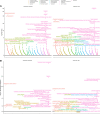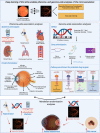Deep Learning of the Retina Enables Phenome- and Genome-Wide Analyses of the Microvasculature
- PMID: 34743558
- PMCID: PMC8746912
- DOI: 10.1161/CIRCULATIONAHA.121.057709
Deep Learning of the Retina Enables Phenome- and Genome-Wide Analyses of the Microvasculature
Abstract
Background: The microvasculature, the smallest blood vessels in the body, has key roles in maintenance of organ health and tumorigenesis. The retinal fundus is a window for human in vivo noninvasive assessment of the microvasculature. Large-scale complementary machine learning-based assessment of the retinal vasculature with phenome-wide and genome-wide analyses may yield new insights into human health and disease.
Methods: We used 97 895 retinal fundus images from 54 813 UK Biobank participants. Using convolutional neural networks to segment the retinal microvasculature, we calculated vascular density and fractal dimension as a measure of vascular branching complexity. We associated these indices with 1866 incident International Classification of Diseases-based conditions (median 10-year follow-up) and 88 quantitative traits, adjusting for age, sex, smoking status, and ethnicity.
Results: Low retinal vascular fractal dimension and density were significantly associated with higher risks for incident mortality, hypertension, congestive heart failure, renal failure, type 2 diabetes, sleep apnea, anemia, and multiple ocular conditions, as well as corresponding quantitative traits. Genome-wide association of vascular fractal dimension and density identified 7 and 13 novel loci, respectively, that were enriched for pathways linked to angiogenesis (eg, vascular endothelial growth factor, platelet-derived growth factor receptor, angiopoietin, and WNT signaling pathways) and inflammation (eg, interleukin, cytokine signaling).
Conclusions: Our results indicate that the retinal vasculature may serve as a biomarker for future cardiometabolic and ocular disease and provide insights into genes and biological pathways influencing microvascular indices. Moreover, such a framework highlights how deep learning of images can quantify an interpretable phenotype for integration with electronic health record, biomarker, and genetic data to inform risk prediction and risk modification.
Keywords: deep learning; epidemiology; genomics; mendelian randomization analysis; microvessels; retina.
Figures








References
-
- Lesnik Oberstein SA, Jukema JW, Van Duinen SG, Macfarlane PW, van Houwelingen HC, Breuning MH, Ferrari MD, Haan J. Myocardial infarction in cerebral autosomal dominant arteriopathy with subcortical infarcts and leukoencephalopathy (CADASIL). Medicine (Baltimore). 2003; 82:251–256. doi: 10.1097/01.md.0000085054.63483.40 - PubMed
-
- Riverol M, Becker JT, López OL, Raji CA, Thompson PM, Carmichael OT, Gach HM, Longstreth WT, Jr, Fried L, Tracy RP, et al. . Relationship between systemic and cerebral vascular disease and brain structure integrity in normal elderly individuals. J Alzheimers Dis. 2015; 44:319–328. doi: 10.3233/JAD-141077 - PMC - PubMed
Publication types
MeSH terms
Grants and funding
- NH/17/1/32725/BHF_/British Heart Foundation/United Kingdom
- R01 HL151283/HL/NHLBI NIH HHS/United States
- R01 HL142711/HL/NHLBI NIH HHS/United States
- RG/19/6/34387/BHF_/British Heart Foundation/United Kingdom
- RE/18/4/34215/BHF_/British Heart Foundation/United Kingdom
- MC_PC_17228/MRC_/Medical Research Council/United Kingdom
- K23 EY032634/EY/NEI NIH HHS/United States
- R01 HL148050/HL/NHLBI NIH HHS/United States
- UL1 TR001863/TR/NCATS NIH HHS/United States
- MC_QA137853/MRC_/Medical Research Council/United Kingdom
- MC_UP_1605/13/MRC_/Medical Research Council/United Kingdom
- R01 HL127564/HL/NHLBI NIH HHS/United States
LinkOut - more resources
Full Text Sources

